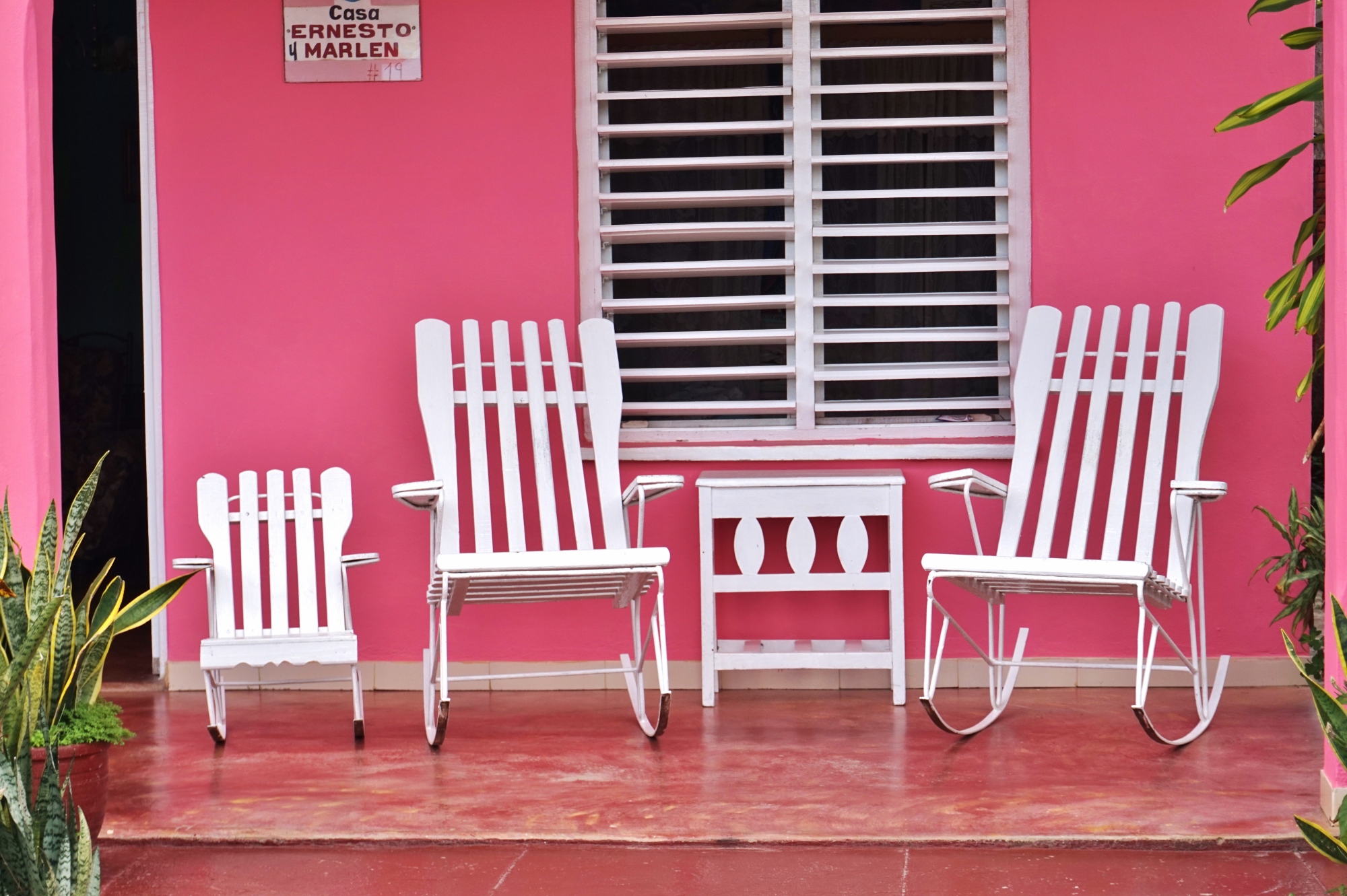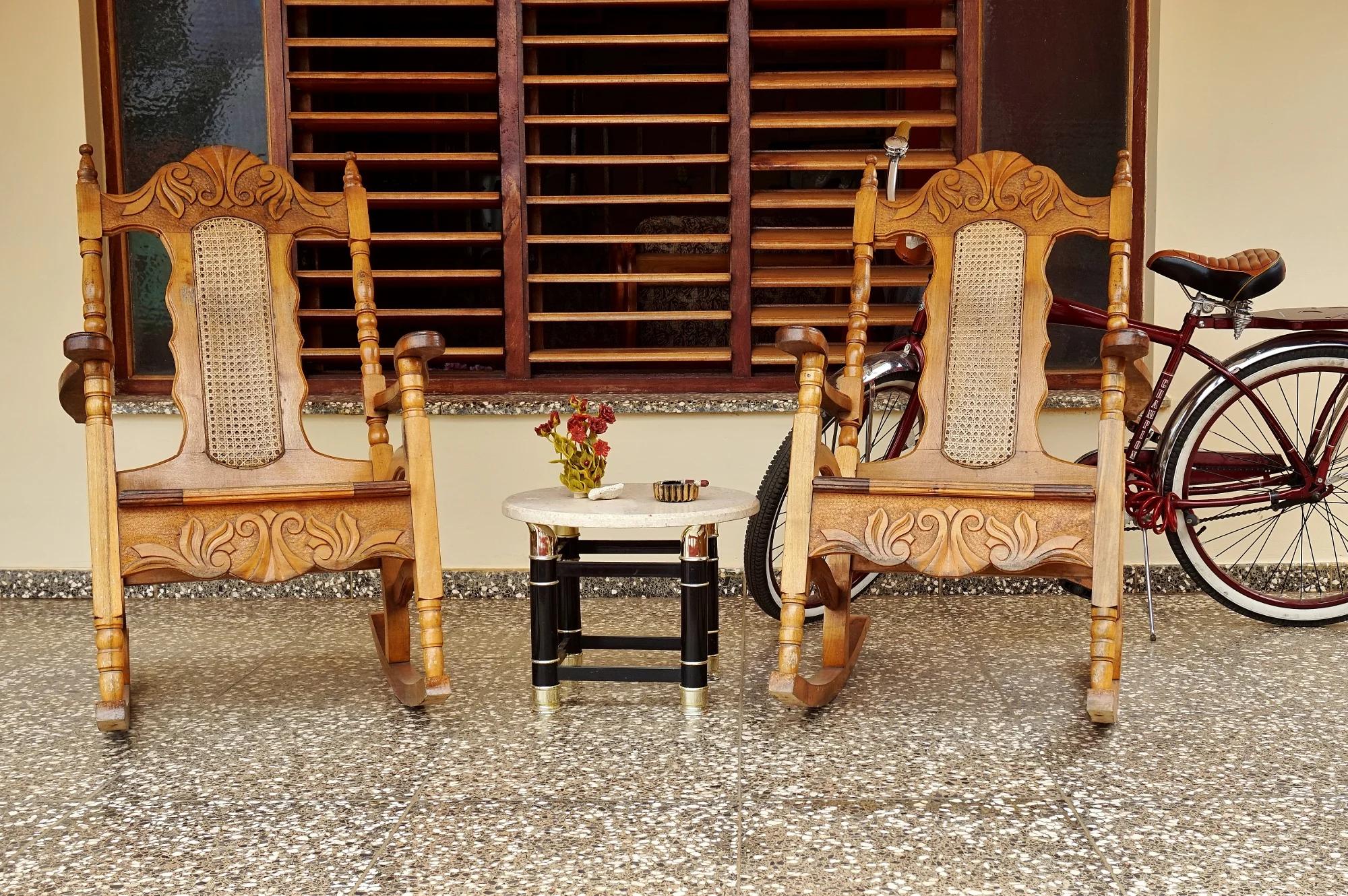VINALES

After the crazy and chaotic city of Havana, Vinales was a breath of fresh air. It's a few hours west of the capital in the hilly countryside of Pina del Rio, an area world famous for its tobacco. Our chariot was a shiny red old station wagon which rolled up round 8:30am. We said our goodbyes to Emilia and piled in. It was like a Tardis inside and seated nine of us in total. As we roared through the Cuban countryside I noticed Dan’s face in the rear view mirror. The top of his head was cut off, but the bottom supported a big grin. This was his first taste of life on the road.
The people of Vinales like to rock! (Generally on their terraces) The sheer amount of rocking chairs was one of my favourite details about this colourful country village.
As well as enough rocking chairs to supply all the retirement homes of Cornwall and the Costa Del Sol, the town also has a lovely little plaza complete with church, trinket shops, restaurants and many pretty lanes leading off into the countryside full of colourful cottages (with matching coloured rocking chairs of course).
Casa de Catalina
Catalina is a lovely lady with an infectious laugh. She and her son Terry have lived in Vinales for their whole lives. We found her place on AirBnB. It is famous for its amazing roof terrace, which didn't disappoint. As soon as we arrived we cracked open a beer on the roof.
Terry loves football (like everyone else in Central and South America) and Mr Bean. This makes sense as Mr Bean doesn't really speak a language. However this caught me off guard slightly as Terry is a security guard, in his mid thirties, and built like a brick shit house. It was funny picturing him chuckling away to old Bean.
It's not just the roof that’s great about Catalina’s, her cooking was ace too. Breakfasts were massive and eliminated the need for lunch. Plus her dinner of locally caught Barrgo fish was one of the best meals we have had so far and almost eliminated the need for breakfast.
Whilst watching night draw in we tried to spot some shooting stars to no avail. However we spotted several fireflies which is kinda the same thing. I must admit I excitedly thought one was a shooting star until it landed on a nearby tree.
Carlos and his car.
Catalina arranged for a friend to run us around some of the sites around Vinales valley on our first afternoon. He was a nice bloke in his late forties who could only speak four or five words of English, three of them being Chelsea Football Club. My Spanish is really being put to the test in Cuba and Dan seems to be picking up a bit.
Cueva Del Indio
Discovered in 1920 in the San Vincente Valley is the Curva Del Indio (Indian Cave). There is a short mosquito-y climb at the beginning that turned me and Dan into itchy sweaty lumps. Luckily the inside of the cave was cooler.
We followed a crooked path through the rock from chamber to chamber, ducking and edging our way around stalactites and mites. The path ended by the San Vincente river. We boarded a small motorboat and headed 1/4 mile up stream. We then did a 180 and followed the river in the other direction until we saw daylight and appeared in a calm jungly lagoon. I wouldn't say Dan found this one particularly easy, but he agreed it was worth the struggle (on reflection and with a bit of coaxing and beer).
Mural de la Prehistoria
Vinales valley is full of huge ancient limestone rocks / mini mountains referred to in Cuba as a Mogotes. One of these Mogotes is home to a huge mural painted in primary colours by painter Leovigildo González. To me it looked like it had been painted by a primary school child. Apparently it depicts the history of evolution. We decided not to pay the $3 dollar per head entrance for a closer look, as I have evolved enough to know when I'm throwing my money away.
Los Jazmines Hotel
The bright pink Los Jazmines Hotel perched atop a ridge is famous worldwide for its incredible view over Vinales valley and its lumpy Mogotes. There is a bar delightfully situated next to the lookout terrace so you can have a beer to accompany your view.
Caballo y Coche (Horse and Cart)
On our second day in Vinales we met up with Angel. This particular Angel has a big beard, is in his late twenties and comes across as quite a player. He is a tour guide for a company recommended by Emilia in Havana. We spent a morning with Angel, a horse called Marron (Brown) and Marron's handler. I never managed to catch his name, even after asking two times. I think the unspoken rule of name asking is three, but I didn't want to push it. He was a strong bloke in a straw hat and cowboy boots who seemed to know every farmer and horse we passed.
Tobacco plantation
Our first stop was a tall palm-roofed barn surrounded by bright orange soil. At the right time of year this would have been full of tobacco plants however they had just finished the final harvest of the season and were preparing the soil for the next crop.
A large sun-baked bloke in a checked shirt, cowboy hat and boots came and greeted us. At no point during the hour or so we spent here did he ever not have a fat cigar on the go. He lit a cigar for each of us and dipped the end in honey. It was surprisingly good!
He explained how the Pinar Del Rio region is the best on the island (and in the world) for growing tobacco. Because of this prestigious title they are forbidden to use any chemicals or pesticides. In other words these cigars are organic and practically good for you, right?
Each part of the tobacco plant has a different quality. The top leaves contain most of the flavour, the middle leaves bring out the cigar’s aroma, and the bottom leaves are the best for combustion. All quality Cuban cigars are hand rolled with a carefully selected balance of the three depending on the desired characteristics.
Once the men have harvested the leaves in the fields the women carefully prepare the leaves to be dried by stringing them up one by one onto long canes which are then hung in the barns rafters for three to four months to dry out. Apparently this is a woman's job because they have small hands and big patience.
The veins of the leaves (which contain the most nicotine) are removed then the leaves are rolled up in paper in the same direction (to help air flow through the cigar) to give it shape. After eight or so hours the cigar is wrapped for a final time in a special outer leaf, apparently "Adding the final wrapper is like a lady dressing for a party". Local honey from Cuban bees (that live in the ground) is used as a glue to hold the final cigar together. After our lesson in cigar making Marron pulled us out into the rolling Vinales countryside.
Coffee & Rum
The story goes there was once a wine maker from Spain who famously said "if I can eat it then I can drink it". He accidentally created the first rum in Pina del Rio and Cuba. The brand is called Los Occidental (The Accident) and the rum is called Guabita de Pina (little guava from Pina). It has a tiny guava fruit in the bottle which is endemic to this area, kind of like the worm in a bottle of tequila. Whether it's true or not we bought into the story and bought two bottles. According to our guide this rum is not allowed to be exported, so visitors can only take two bottles each out of the country.
We also tried some of the local coffee produced here. Compared to our hour long demonstration of the cigar making process, the thirty second overview about Cuban coffee production was a bit shit. But at least the coffee tasted good.
Hills & lakes
We cantered on through the countryside and stopped off at a tranquil look out over the valley.
A short walk away was a little bar overlooking a calm lake. It was a peaceful spot where we just chatted to Angel and drank fresh mango juice.
Casa Del La Musica
Although a tad touristy, Casa Del La Musica seems to be the only sign of life in Vinales after the restaurants close. It's an open air bar set around a stage and dance floor. When we arrived, two big guys were shouting at each other and getting right up in each other’s faces. I thought it was about to explode in a massive fight as other folks chimed in. I later found out they were arguing over who is better, Messi or Ronaldo, a subject that splits most of Cuba in half and often comes to blows. We grabbed a table in the corner, as numerous singers and dances took to the stage and dance floor. We left round midnight for a cigar and beer on our little terrace outside our room. The stars were out in force as we talked drunken rubbish until the wee hours. We instantly regretted this decision the next morning as we dragged ourselves out of bed for our 8am six hour drive east to Cienfuegos.





















































































































